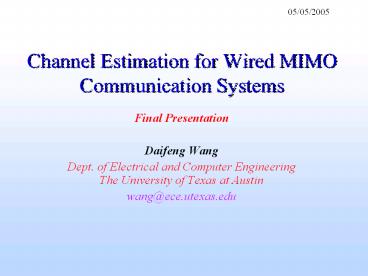Channel%20Estimation%20for%20Wired%20MIMO%20Communication%20Systems - PowerPoint PPT Presentation
Title:
Channel%20Estimation%20for%20Wired%20MIMO%20Communication%20Systems
Description:
Which channel estimation strategy for wired communication systems? ... [Chen & Mitra, 2000] Time. Optimal Sequence* Complexity. Minimum. MSE. Method. Domain ... – PowerPoint PPT presentation
Number of Views:144
Avg rating:3.0/5.0
Title: Channel%20Estimation%20for%20Wired%20MIMO%20Communication%20Systems
1
Channel Estimation for Wired MIMO Communication
Systems
05/05/2005
- Final Presentation
- Daifeng Wang
- Dept. of Electrical and Computer EngineeringThe
University of Texas at Austin - wang_at_ece.utexas.edu
2
Introduction
- Review
- Wired MIMO Communication Systems
- Multicarrier Modulation
- Training-Based Channel Estimation
- Today
- Which channel estimation strategy for wired
communication systems? - How to design the training sequence?
- What is the channel model?
- How to estimate
- the wired MIMO
- channel?
3
Training-Based Channel Estimation Strategy
- Block-Type
- All subcarriers Period
- Least Square (LS), Minimum Mean-Square (MMSE)
- Slow Fading/Varying Channels
- Decision Feedback Equalizer
- Comb-Type
- Selective subcarriers Interpolation
- LS, MMSE, Least Mean-Square (LMS)
- Fast Fading/Varying Channels
- Interpolation
- Linear
- Second order
- Low-pass
- Spline Cubic
- Time domain
Tradeoff between performance and complexity
4
Training Sequences
- y S h n
- h L-tap channel
- S transmitted N x L Toeplitz matrix made up of N
training symbols - n AWGN
Domain Method Minimum MSE Complexity Optimal Sequence
Time Periodic Chen Mitra, 2000 Yes High(2N) Yes
Time Aperiodic Tella, Guo Barton, 1998 No Medium(N2) Yes
Time L-Perfect (MIMO) Fragouli, Dhahir Turin, 2003 Almost Low(Nlog2N) Sometimes
Frequency Periodic Tella, Guo Barton, 1999 No Low(Nlog2N) Sometimes
impulse-like autocorrelation and zero
crosscorrelation
5
Training-Based MIMO Channel Model
- 2 X 2 MIMO Model
TX 1
RX 1
h11
h12
h21
TX 2
RX 2
h22
6
Training-Based Channel Estimation for MIMO
- Least Square (LS)
- Assumes S has full column rank
- Mean-Square (MSE)
- zero-mean and white Gaussian noise
- Sequences satisfy above are optimal sequences
- Optimal sequences impulse-like autocorrelation
and zero crosscorrelation































